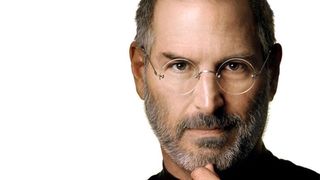The Appleseed legend: the story behind Apple's unofficial mascot
Heeere's Johnny!

Inevitably, Apple fans tried to get in touch. "John was pretty pissed about that," our source told us. "He had to change his number pretty much straight away." Jobs apologised, but similar errors would plague Appleseed over the years: he had to take down his Facebook account after it was featured in an iPhoto demo, and at WWDC 2008 he was alarmed to see his name on the 'fusion of CT and PET' scan demoed by MIMVista.
"The actual scan wasn't John," our source says, "but he'd had his details leaked so many times that he just assumed that it was." Appleseed put up with it, though. Irritations aside, he enjoyed being in the (infinite) loop, the feeling of being part of a remarkable business success story.
Out of the loop
Tim Cook didn't share Steve Jobs' high opinion of Appleseed, though, and when he became CEO, it was the beginning of the end. Jonathan Ive for one was relieved.
"Jony never understood why Steve liked having him around, so he was pleased when Tim cut the lines of communication," our source says. "But Appleseed took it hard." Appleseed took the excommunication very personally. It didn't help that Apple had found a new family for its product demos: from late 2011, Apple marketing featured younger, prettier individuals such as Kevin Dolan, Katharine Johnson and Janielle Penner. "John started drinking," a friend told us. "It became a real problem for him."
Appleseed would call Apple HQ at strange hours, leaving long, rambling messages. On several occasions he turned up at Infinite Loop, clearly the worse for wear, and rumours swirled that his wife, Kate, had kicked him out of the house. It was surprising, therefore, to see his face at this year's WWDC - not outside, trying to get in, but up on the big screen as Tim Cook demoed iOS In The Car.
"That was a real dick move," the friend says. "The guy's basically living in his car by this point, and they're using his face to demo in-car entertainment. There's no way that wasn't deliberate."
It's clear that whatever the future holds for John Appleseed, he isn't going to find it at Apple. "John was never part of the Apple family," our source explains. "He was part of Steve's family. And when Steve died…" Looking back on the keynotes now, the irony is obvious: while there's endless footage showing Appleseed calling Apple, there's no footage of anybody actually taking his calls.
Get daily insight, inspiration and deals in your inbox
Sign up for breaking news, reviews, opinion, top tech deals, and more.
The real Appleseed
The real Johnny Appleseed isn't any relation to the fictitious one you see in Apple's marketing materials and keynotes: the original Appleseed died in 1845. It wasn't his real name, either: he was born John Chapman in 1774. Appleseed came later when he was a nurseryman, bringing non-native apple trees to parts of Indiana, Illinois, Ohio and Pennsylvania.
Chapman was an American folk hero, but unusually he didn't have to wait until he was dead to become one; in 1830, when Chapman was very much alive, author Henry Howe collated many stories of his exploits. The stories paint Chapman as quite the role model: he was kind, lived humbly, cared for animals and preached the gospel as he travelled. He was a friend to Native Americans, cared about the environment and was more interested in helping others than amassing a personal fortune.
According to The Straight Dope, his attitudes were the opposite of other frontiersmen and women: "He thought it cruel to ride a horse, chop down a tree, or kill a rattlesnake." The legend portrays Chapman as a dreamer, merrily scattering apple seeds as he strolled, but he was much more organised than that: Chapman created plant nurseries and returned regularly to check on them - and he planted the nurseries where he predicted settlers would one day come. When his predictions, ahem, bore fruit his trees were already several years old and ready to sell - and they sold because the apples they grew were perfect for making alcohol.
Like Steve Jobs, Chapman had charisma: as one lady told Harper's New Monthly Magazine in 1871, "His was a strange eloquence at times, and he was undoubtedly a man of genius." She was clearly rather taken with him, but then again, he wasn't the kind of person you'd forget in a hurry: big-boned and sinewy, dressed in an old sack, wearing a tin pot on his head.
Chapman died in 1845, but his legend lives on in everything from Disney cartoons to NOFX records and the icon for Logic Pro X. Johnny Appleseed may be dead, but he certainly hasn't been forgotten.
- Why not check out what we thought of iTunes Radio?
Writer, broadcaster, musician and kitchen gadget obsessive Carrie Marshall has been writing about tech since 1998, contributing sage advice and odd opinions to all kinds of magazines and websites as well as writing more than a dozen books. Her memoir, Carrie Kills A Man, is on sale now and her next book, about pop music, is out in 2025. She is the singer in Glaswegian rock band Unquiet Mind.












